The body of 84-year-old Indian Jesuit priest Stan Swamy, who died under detention, was cremated on July 6 after a court asked Jesuit officials to follow prison rules. Father Stan Swamy was championing the rights of indigenous and marginalized people in eastern India’s Jharkhand state, breathed his last at the Holy Family Hospital in Bandra, Mumbai, where he was admitted for treatment over a month ago. Father Swamy was a Jesuit for 64 years, and a priest for 51 years.
The body of Father Swamy, who died of post-Covid-19 complications on July 5 in church-run Holy Family Hospital in Mumbai, was taken to a government crematorium after a requiem Mass. “Although he was free from Covid-19, we have been asked by the court to follow prison rules,” Jesuit Father Joseph Xavier said at the end of the July 6 funeral service after announcing the decision to cremate the priest’s body. Father Swamy’s body was cremated in an electric crematorium at around 6.30pm after the funeral Mass, Father Joseph told UCA News on July 7.
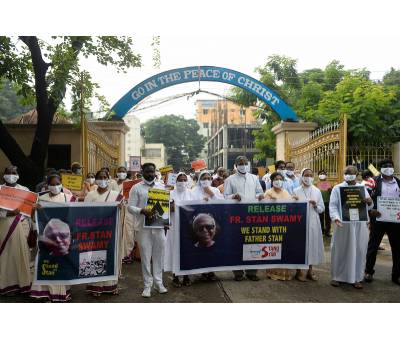 Dr. Stanislaus D’Souza SJ, the Jesuit Provincial of India, said: “With a deep sense of pain, anguish and hope we have surrendered Fr Stan Swamy, aged 84, to his eternal abode.”The funeral service and Mass was led by Father Arun De Souza, Jesuit provincial of Mumbai, at St. Peter’s Church in Bandra, a Mumbai suburb. Only some 20 people attended the service because of Covid-19 restrictions. Jesuits said the ashes will be carried to Ranchi town in eastern India where the missionary priest was based and to Jamshedpur town, the base of his Jesuit province. Father Stanislaus Arulswamy, known popularly as Stan Swamy had Parkinson’s disease, developed a pulmonary infection, post-Covid-19 complications in the lungs and pneumonia, according to the hospital’s medical director Ian D’Souza. India’s National Investigation Agency (NIA) that is tasked with fighting terrorism and sedition under the controversial Unlawful Activities (Prevention) Act (UAPA), arrested Father Swamy on October 8 from Bagaicha, a Jesuit social action center on the outskirts of Ranchi, the capital of the eastern state of Jharkhand.
Dr. Stanislaus D’Souza SJ, the Jesuit Provincial of India, said: “With a deep sense of pain, anguish and hope we have surrendered Fr Stan Swamy, aged 84, to his eternal abode.”The funeral service and Mass was led by Father Arun De Souza, Jesuit provincial of Mumbai, at St. Peter’s Church in Bandra, a Mumbai suburb. Only some 20 people attended the service because of Covid-19 restrictions. Jesuits said the ashes will be carried to Ranchi town in eastern India where the missionary priest was based and to Jamshedpur town, the base of his Jesuit province. Father Stanislaus Arulswamy, known popularly as Stan Swamy had Parkinson’s disease, developed a pulmonary infection, post-Covid-19 complications in the lungs and pneumonia, according to the hospital’s medical director Ian D’Souza. India’s National Investigation Agency (NIA) that is tasked with fighting terrorism and sedition under the controversial Unlawful Activities (Prevention) Act (UAPA), arrested Father Swamy on October 8 from Bagaicha, a Jesuit social action center on the outskirts of Ranchi, the capital of the eastern state of Jharkhand.
The following day, he was lodged in Taloja Jail, near Mumbai. He was arrested for alleged links with Maoist insurgents who were said to have been behind the caste-based violence in BhimaKoregaon village in Maharashtra state in January 2018, in which one person was killed and many others injured. Fifteen others, including scholars, lawyers, academicians, cultural activists and an ageing radical poet, have also been implicated in the same case. Father Swamy who suffered from Parkinson’s disease had difficulty in even sipping water from a glass and depended on co-prisoners for his other basic needs. Besides, he also had hearing impairment and other age-related ailments.
The NIA court denied him bail twice, forcing him to twice move the Bombay High Court for bail. In the second week of May, the priest’s family members sought his release on grounds that he had contracted Covid-19 and was unable to even speak to his lawyers. While hearing his bail plea on health grounds on May 21 through a video linkup, the Bombay High Court sensed Fr. Swamy’s failing health, and offered him treatment in a government or private hospital. But the Jesuit turned down the offer, saying all he wanted was bail to go back to his home. “I would rather suffer, possibly die very shortly if this were to go on,” he said. He explained that when he arrived at the prison, his bodily systems “were very functional”, but in the over 7 months in prison, “there has been a steady, slow regression” of his health.
JCSA said “the Bombay High Court was hearing some petitions, seeking bail and a constitutional challenge to a section of UAPA, on July 5 when his lawyer announced Stan Swamy’s death.” “He suffered a cardiac arrest at 4.30 am on Saturday, and deteriorated thereafter,” JCSA said. The Archdiocese of Ranchi where Father Swamy served hailed him as “a champion of tribal rights, a fighter for justice and a symbol of courage”. “The fact that this sick man suffering with Parkinson disease was arrested at the age of 84, refused bail for over 7 months, not even allowed a sipper and finally contracted COVID in jail, itself is a sad reflection on those who got the innocent man arrested and the courts that refused to give him bail,” said a statement signed by
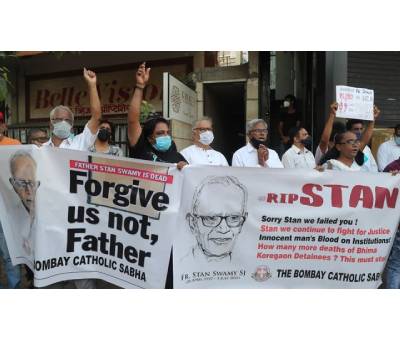 Archbishop Felix Toppo of Ranchi and Auxiliary Bishop Theodore Mascarenhas. “The ‘caged parrot’ now sings in heaven but its blood is on our hands,” they wrote, “May the hand of God intervene to bring justice to all innocent victims of insensitivity, vindictiveness and injustice. We have lost Fr. Stan Swamy but we still hope in the God of justice,” they added.The Jamshedpur Jesuit Province, to which Father Swamy belonged, also expressed “a deep sense of pain, anguish and hope” at the death of the “servant in mission of justice and reconciliation”. In a Facebook post, Father Jerome Cutinha noted that the “author of life” had given Father Swamy “a mission to work among the Advasis [indigenous], Dalits [downtrodden] and other marginalized communities so that the poor may have life and life to the full, with dignity and honour”. “The Society of Jesus [Jesuits], at this moment, recommits itself to take forward the legacy of Fr. Stan in hits mission of justice and reconciliation,” Father Cutinha wrote.
Archbishop Felix Toppo of Ranchi and Auxiliary Bishop Theodore Mascarenhas. “The ‘caged parrot’ now sings in heaven but its blood is on our hands,” they wrote, “May the hand of God intervene to bring justice to all innocent victims of insensitivity, vindictiveness and injustice. We have lost Fr. Stan Swamy but we still hope in the God of justice,” they added.The Jamshedpur Jesuit Province, to which Father Swamy belonged, also expressed “a deep sense of pain, anguish and hope” at the death of the “servant in mission of justice and reconciliation”. In a Facebook post, Father Jerome Cutinha noted that the “author of life” had given Father Swamy “a mission to work among the Advasis [indigenous], Dalits [downtrodden] and other marginalized communities so that the poor may have life and life to the full, with dignity and honour”. “The Society of Jesus [Jesuits], at this moment, recommits itself to take forward the legacy of Fr. Stan in hits mission of justice and reconciliation,” Father Cutinha wrote.
“We are deeply saddened at the passing away of Fr. Stan Swamy. We give thanks to God for Fr. Stan’s life and commitment to the poor indigenous people and their struggles,” wrote Cardinal Oswald Gracias of Bombay in a brief statement. “Fr. Stan’s arrest was very painful,” lamented the cardinal who is President of the Catholic Bishops’ Conference of India (CBCI). “Under the Indian criminal law, one is innocent until proved guilty,” he wrote. “Fr. Stan’s case did not even come up for hearing. We were eagerly waiting for the case to be taken up and the truth to come out,” the cardinal wrote.
Fr. Swamy’s commitment
Father Swamy has denied all charges against him saying BhimaKoregaon is “a place that I have never been to in all my life.” However, sensing his imminent arrest, he had released a video message explaining his situation. He said that what was happening to him was not something unique or happening to him alone. “It’s a broader process that is taking place over the country.” Prominent intellectuals, lawyers, writers, poets, activists and student leaders, he said, “are all put into jail just because they have expressed dissent…”.
This however did not dim his resolve to pursue his convictions. “I am happy to be part of this process because I am not a silent spectator,” he said in the video. He explained that with the creation of Jharkhand state in 2000, there were issues, such as displacement and land alienation because of mining, factories townships and dams”, in which the people who owned that land were not consulted. He engaged young activists to resort to the country rulings or laws that empowered the indigenous people in issues regarding their lands and territories.
The death in India of an octogenarian human rights activist who was denied bail even as his health deteriorated in prison has sparked anger across the country, with critics decrying the government’s alleged misuse of anti-terrorism laws. For decades, he fought for the human rights of India’s marginalized and indigenous groups, speaking and writing in depth about caste-based injustices.
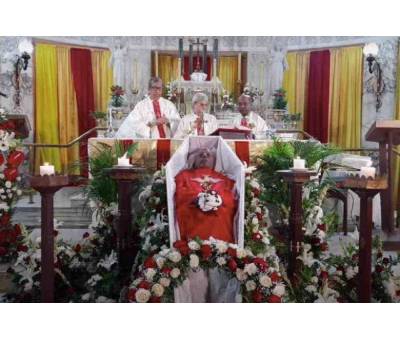 India’s caste system was officially abolished in 1950, but the 2,000-year-old social hierarchy imposed on people by birth still exists in many aspects of life. The caste system categorizes Hindus at birth, defining their place in society, what jobs they can do and who they can marry. In October last year, Swamy was arrested and charged under the country’s anti-terrorism laws, which critics have described as draconian.
India’s caste system was officially abolished in 1950, but the 2,000-year-old social hierarchy imposed on people by birth still exists in many aspects of life. The caste system categorizes Hindus at birth, defining their place in society, what jobs they can do and who they can marry. In October last year, Swamy was arrested and charged under the country’s anti-terrorism laws, which critics have described as draconian.
Stan Swamy was among 16 renowned activists, academics and lawyers who were charged under a draconian anti-terror law in what came to be known as the BhimaKoregaon case. Prison authorities were criticized for denying him access to basic amenities such as a straw and sipper – a plastic drinking beaker with a spout or straw – which he needed to drink water because of hand tremors caused by Parkinson’s. The Elgar Parishad case is related to inflammatory speeches made at a conclave held in Pune on December 31, 2017, which, the police claimed, triggered violence the next day near the Koregaon-Bhima war memorial located on the outskirts of the western Maharashtra city. The police had claimed the conclave was organized by people with alleged Maoist links.
Human Rights Violated: Modi Regime Abuses Power
Stan Swamy’s arrest sparked outrage worldwide, prompting several opposition politicians, national and international rights groups to demand his release. The others accused in the case termed Stan Swamy’s death an “institutional murder” and held the “negligent jails, indifferent courts and malicious investigating agencies” responsible for it. As a mark of protest, 10 of the co-accused in the case – Rona Wilson, SurendraGadling, SudhirDhawale, Mahesh Raut, Arun Ferreira, Vernon Gonsalves, GautamNavlakha, AnandTeltumbde, Ramesh Gaichor and SagarGorkhe – went on a one-day fast in the Taloja jail on Wednesday.
They informed about the protest to their family members, who released a statement saying all Elgar case prisoners have blamed the NIA and the Taloja jail’s former superintendent KaustubhKurlekar for the death of Father Stan Swamy. They believe that “the separation of Stan Swamy from them is a deliberate institutional murder,” the release said. The statement alleged that the NIA and Kurlekar never missed a single opportunity to “harass” Stan Swamy, whether it was the “ghastly treatment” inside the jail, the haste to transfer him back from hospital to jail or even protesting against trivial things like a sipper (which Stan Swamy required due to his medical conditions).
“It is these that have caused the death of Stan Swamy and therefore, for this institutional murder, NIA officials and Kurlekar should be tried under Section 302 (murder) of the Indian Penal Code,” the statement said, while demanding a judicial inquiry into his death.
The statement said the family members of the accused will submit these demands to Maharashtra Chief Minister Uddhav Thackeray through the Taloja jail administration. It also said that though these accused were lodged in different barracks, they met on Tuesday and shared their memories of Father Stan Swamy, and also observed a two-minute silence as a mark of tribute to him. Three women accused in the case- SudhaBharadwaj, Shoma Sen and JyotiJagtap – are currently lodged at the Byculla prison in Mumbai.
The United Nations Human Rights on Tuesday issued a statement on his death and detention, criticising India. The international body tweeted, “We are saddened and disturbed by the death of 84-year-old human rights defender Father Stan Swamy, after prolonged pre-trial detention. With Covid-19, it is even more urgent that states release every person detained without sufficient legal basis.” In its statement, the UN Human Rights’ office of the high commissioner had said that Father Stan had been held in pre-trial detention without bail since his arrest, charged with terrorism-related offences in relation to demonstrations that date back to 2018.
“High Commissioner Michelle Bachelet and the UN’s independent experts have repeatedly raised the cases of Father Stan and 15 other human rights defenders associated with the same events with the Government of India over the past three years and urged their release from pre-trial detention. The High Commissioner has also raised concerns over the use of the UAPA in relation to human rights defenders, a law Father Stan was challenging before the Indian courts days before he died,” the UN statement said. “We stress, once again, the High Commissioner’s call on the Government of India to ensure that no one is detained for exercising their fundamental rights to freedom of expression, of peaceful assembly and of association,” Bachelet said in her statement.
An international alliance of civil rights groups has blamed the administration of Prime Minister Narendra Modi for the death of an 84-year-old Jesuit social activist who died under detention. Human rights defender Father Stan Swamy’s death on July 5 while awaiting trial has deeply shocked and outraged global civil society alliance CIVICUS. A slew of opposition politicians, rights groups and academics, have expressed sadness for his death — as well as anger for the laws under which he was arrested and denied bail. Critics have long accused India’s government of increasingly using anti-terrorism laws as a means to quell any form of dissent.
Harsh Mander, a prominent Indian rights activist called Swamy’s death a “tragedy for the nation.” “A cruel state jailed him to silence his voice, the judiciary did nothing to secure his freedom,” he said on Twitter. International figures have spoken out as well — the European Union’s special representative for human rights said the EU had been “raising his case repeatedly with authorities,” calling Swamy a “defender of indigenous people’s rights.”
MeenakshiGanguly, South Asia director of Human Rights Watch, said Swamy’s arrest highlights “a degree of cruelty and callousness that is shameful.” “The counter terror law is draconian. We see it is being used rampantly to jail peaceful critics without bail,” Ganguly said. “It was for the courts to decide if Swamy was guilty, but in repeatedly stifling bail, the authorities chose not to protect,” the “fragile, ailing” activist, she added.
The priest’s death “is a result of the persecution he has faced by the Modi government after revealing abuses by the state,” the group said in a press statement. “Swamy’s death is a tragic loss for civil society and highlights the dangerous situation for other human rights defenders currently in jail in India,” said Lysa John, CIVICUS secretary-general. “Human rights activism and criticism of the state should not amount to the equivalent of a death sentence.”
Thousands of activists, political leaders and Indian citizens have taken to social media to pay tributes to Stan Swamy. Many also expressed anger at the way he was jailed during Covid-19 and repeatedly denied bail. The government said Swamy’s arrest followed “due process under law”. Historian Ramachandra Guha called his death “a case of judicial murder“. Leader of the main opposition Congress party Rahul Gandhi tweeted that “he deserved justice and humaneness”:
Indian American organizations have condemned the death of Father Stan Swamy, the 84-year-old defender of indigenous peoples’ rights in India, calling it a blot on India’s consciousness. “It is a dark day for democracy in India, and the national leadership and members of the judiciary should hang their heads in shame” questioning the failure of freedom of expression in a democratic nation,” George Abraham, vice-chairman of the Indian Overseas Congress, said in a statement.
In his last bail hearing in May, Swamy had predicted his death. “I would rather suffer, possibly die here very shortly if this were to go on,” he told the judges. The Indian Express newspaper said Swamy’s death had “left the highest institutions of India’s justice system diminished”.”In the nearly nine months of his incarceration, till his death, the ailing activist came up – again and again – against the heavy hand of the state, an unresponsive judiciary and a broken prison system,” the newspaper said in an editorial. Chief Minister Hemant Soren of the eastern state of Jharkhand – where Swamy lived and worked – said the federal government “should be answerable for absolute apathy and non provision of timely medical services, leading to his death”.
 Justice Ravendran will be assisted in this task by Alok Joshi, former IPS officer (1976 batch) and Sundeep Oberoi, Chairman, Sub Committee in (International Organisation of Standardisation/International Electro-Technical Commission/Joint Technical Committee). The three technical members of the committee are Naveen Kumar Chaudhary, Professor (Cyber Security and Digital Forensics) and Dean, National Forensic Sciences University, Gandhinagar, Gujarat; Prabaharan P, Professor (School of Engineering), Amrita Vishwa Vidyapeetham, Amritapuri, Kerala; and Ashwin Anil Gumaste, Institute Chair Associate Professor (Computer Science and Engineering), Indian Institute of Technology, Bombay, Maharashtra.
Justice Ravendran will be assisted in this task by Alok Joshi, former IPS officer (1976 batch) and Sundeep Oberoi, Chairman, Sub Committee in (International Organisation of Standardisation/International Electro-Technical Commission/Joint Technical Committee). The three technical members of the committee are Naveen Kumar Chaudhary, Professor (Cyber Security and Digital Forensics) and Dean, National Forensic Sciences University, Gandhinagar, Gujarat; Prabaharan P, Professor (School of Engineering), Amrita Vishwa Vidyapeetham, Amritapuri, Kerala; and Ashwin Anil Gumaste, Institute Chair Associate Professor (Computer Science and Engineering), Indian Institute of Technology, Bombay, Maharashtra. The committee has been asked make recommendations on:
The committee has been asked make recommendations on:
 US Senators and India Caucus Co-Chairs Mark Warner and John Cornyn sent a letter to President Biden encouraging him to waive CAATSA sanctions against India. India signed a $5.43-billion deal with Russia for the purchase of five S-400 surface to air missile systems during the 19th India-Russia Annual Bilateral Summit in New Delhi on October 5, 2019, for long-term security needs.
US Senators and India Caucus Co-Chairs Mark Warner and John Cornyn sent a letter to President Biden encouraging him to waive CAATSA sanctions against India. India signed a $5.43-billion deal with Russia for the purchase of five S-400 surface to air missile systems during the 19th India-Russia Annual Bilateral Summit in New Delhi on October 5, 2019, for long-term security needs. PM Narendra Modi tweeted: “The journey from anxiety to assurance has happened and our nation has emerged stronger, thanks to the world’s largest vaccination drive.”
PM Narendra Modi tweeted: “The journey from anxiety to assurance has happened and our nation has emerged stronger, thanks to the world’s largest vaccination drive.” Deputy Assistant Attorney General Arun G. Rao of the U.S. Department of Justice Civil Division’s Consumer Protection Branch, together with colleagues from the Consumer Protection Branch and the Federal Bureau of Investigation (FBI), met this week with Central Bureau of Investigation (CBI) officials in New Delhi to further strengthen law enforcement cooperation.
Deputy Assistant Attorney General Arun G. Rao of the U.S. Department of Justice Civil Division’s Consumer Protection Branch, together with colleagues from the Consumer Protection Branch and the Federal Bureau of Investigation (FBI), met this week with Central Bureau of Investigation (CBI) officials in New Delhi to further strengthen law enforcement cooperation. In early October, Ayyub was rushed to the hospital in the middle of the night with a suspected heart attack. She remembers screaming to doctors in her hospital bed: “I’m dying.” The scare turned out to be a palpitation, and she was prescribed blood pressure medication. “It happened because I was fearful of my life,” Ayyub, 37, says in a phone interview with TIME two weeks later. “I was just tired of this existence.”
In early October, Ayyub was rushed to the hospital in the middle of the night with a suspected heart attack. She remembers screaming to doctors in her hospital bed: “I’m dying.” The scare turned out to be a palpitation, and she was prescribed blood pressure medication. “It happened because I was fearful of my life,” Ayyub, 37, says in a phone interview with TIME two weeks later. “I was just tired of this existence.” The GHI score is calculated on four indicators — undernourishment; child wasting (the share of children under the age of five who low weight for their height); child stunting (children under the age of five who have low height for their age) and child mortality (the mortality rate of children under the age of five).
The GHI score is calculated on four indicators — undernourishment; child wasting (the share of children under the age of five who low weight for their height); child stunting (children under the age of five who have low height for their age) and child mortality (the mortality rate of children under the age of five). She further said, “I have always appreciated frankness. There is no need to speak to me through the media. So let us all have a free and honest discussion. But what should get communicated outside the four walls of this room is the collective decision of the CWC.”
She further said, “I have always appreciated frankness. There is no need to speak to me through the media. So let us all have a free and honest discussion. But what should get communicated outside the four walls of this room is the collective decision of the CWC.” Shri Muraleedharan, who officially took charge as Minister of State for External Affairs and Minister of State for Parliamentary Affairs in May 2019, is visiting the United States to address the United Nations. He took the opportunity to travel to Connecticut to “listen” directly to the Diaspora and address their concerns. “I’ve been in charge of the External Affairs Ministry for the last 2 years. I was feeling that there is a need for interaction with the Diaspora. And this forum is a place where people have an opportunity to share their problems and concerns,” he told the audience. While assuring the community that he has listened to the concerns of the Diaspora, he will address each one of them and find an amicable solution.
Shri Muraleedharan, who officially took charge as Minister of State for External Affairs and Minister of State for Parliamentary Affairs in May 2019, is visiting the United States to address the United Nations. He took the opportunity to travel to Connecticut to “listen” directly to the Diaspora and address their concerns. “I’ve been in charge of the External Affairs Ministry for the last 2 years. I was feeling that there is a need for interaction with the Diaspora. And this forum is a place where people have an opportunity to share their problems and concerns,” he told the audience. While assuring the community that he has listened to the concerns of the Diaspora, he will address each one of them and find an amicable solution. Among others who attended the Reception and the Interactive Session with the Honorable Minister Shri V. Muraleedharan, included, Deputy Consul General of Indian in New York, Dr. Varun Jeph; Consul for Community Affairs at the Indian Consulate Mr. A.K.Vijayakrishan; CT Assemblyman Harry Arora, several community organizations including Milan cultural Association President Suresh Sharma; Past President of the Federation of Indian Associations of New York, New Jersey and CT, Andy Bhatia; CT Tamil Sangam President Shivakumar Subramaniam and past president Uma Sekhar; CT Telugu Association Past President Rao Yelamachali; Malayalee Association of Southern Connecticut President T.P. Sujanan; GOPIO Media Council Chair Nami Kaur; Sabinsa Corporation President Dr. Asha Ramesh; and former Provost and Vice President of Academic affairs of GOPIO, Dr. Rupendra Paliwal.
Among others who attended the Reception and the Interactive Session with the Honorable Minister Shri V. Muraleedharan, included, Deputy Consul General of Indian in New York, Dr. Varun Jeph; Consul for Community Affairs at the Indian Consulate Mr. A.K.Vijayakrishan; CT Assemblyman Harry Arora, several community organizations including Milan cultural Association President Suresh Sharma; Past President of the Federation of Indian Associations of New York, New Jersey and CT, Andy Bhatia; CT Tamil Sangam President Shivakumar Subramaniam and past president Uma Sekhar; CT Telugu Association Past President Rao Yelamachali; Malayalee Association of Southern Connecticut President T.P. Sujanan; GOPIO Media Council Chair Nami Kaur; Sabinsa Corporation President Dr. Asha Ramesh; and former Provost and Vice President of Academic affairs of GOPIO, Dr. Rupendra Paliwal. “India is fully democratic. Judiciary is independent. Media is free. There is no substance to claims that the media is controlled” by the government, declared Shri V. Muraleedharan, who is visiting the United States to address the United Nations.
“India is fully democratic. Judiciary is independent. Media is free. There is no substance to claims that the media is controlled” by the government, declared Shri V. Muraleedharan, who is visiting the United States to address the United Nations. Among others who attended the Reception and the Interactive Session with the Honorable Minister Shri V. Muraleedharan, included, Deputy Consul General of Indian in New York, Dr. Varun Jeph; Consul for Community Affairs at the Indian Consulate Mr. A.K.Vijayakrishan; CT Assemblyman Harry Arora, several community organizations including Milan cultural Association President Suresh Sharma; Past President of the Federation of Indian Associations of New York, New Jersey and CT, Andy Bhatia; CT Tamil Sangam President Shivakumar Subramaniam and past president Uma Sekhar; CT Telugu Association Past President Rao Yelamachali; Malayalee Association of Southern Connecticut President T.P. Sujanan; GOPIO Media Council Chair Nami Kaur; Sabinsa Corporation President Dr. Asha Ramesh; and former Provost and Vice President of Academic affairs of GOPIO, Dr. Rupendra Paliwal.
Among others who attended the Reception and the Interactive Session with the Honorable Minister Shri V. Muraleedharan, included, Deputy Consul General of Indian in New York, Dr. Varun Jeph; Consul for Community Affairs at the Indian Consulate Mr. A.K.Vijayakrishan; CT Assemblyman Harry Arora, several community organizations including Milan cultural Association President Suresh Sharma; Past President of the Federation of Indian Associations of New York, New Jersey and CT, Andy Bhatia; CT Tamil Sangam President Shivakumar Subramaniam and past president Uma Sekhar; CT Telugu Association Past President Rao Yelamachali; Malayalee Association of Southern Connecticut President T.P. Sujanan; GOPIO Media Council Chair Nami Kaur; Sabinsa Corporation President Dr. Asha Ramesh; and former Provost and Vice President of Academic affairs of GOPIO, Dr. Rupendra Paliwal. Ashish Mishra,
Ashish Mishra,  Ashish
Ashish “I hope his White House visit includes honest conversations about how the Modi government can ensure India’s democracy remains a democracy for all of its people,” said US Representative Andy Levin (Democrat, Michigan). Others pointed to Biden and Harris stressing on threats to democracy globally and underlining the values of Mahatma Gandhi. In the realm of trade and economy, too, Silicon Valley voices were not exuberant in their praise of the visit. A number of them pointed out that India currently has no trade agreement with the United States of America.
“I hope his White House visit includes honest conversations about how the Modi government can ensure India’s democracy remains a democracy for all of its people,” said US Representative Andy Levin (Democrat, Michigan). Others pointed to Biden and Harris stressing on threats to democracy globally and underlining the values of Mahatma Gandhi. In the realm of trade and economy, too, Silicon Valley voices were not exuberant in their praise of the visit. A number of them pointed out that India currently has no trade agreement with the United States of America.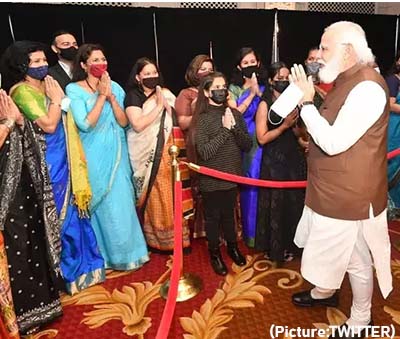 The diaspora factor was also very evident at PM Modi’s meeting with US Vice President Kamala Harris. He told Harris “between India and the US, we have very vibrant and strong people-to-people connections, you know that all too well,” referring to her Indian roots.
The diaspora factor was also very evident at PM Modi’s meeting with US Vice President Kamala Harris. He told Harris “between India and the US, we have very vibrant and strong people-to-people connections, you know that all too well,” referring to her Indian roots. 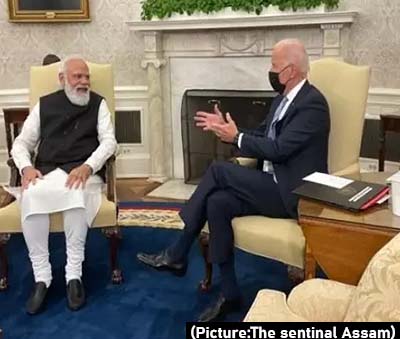 Modi echoed the sentiments. “Today’s bilateral summit is important. We are meeting at the start of the third decade of this century,” said Prime Minister Modi. “Your leadership will certainly play an important role in how this decade is shaped. The seeds have been sown for an even stronger friendship between India and USA,” he added. “The Prime Minister and I are going to be talking today about what more we can do to fight Covid-19, take on the climate challenges that the world face(s), and ensure stability in the Indo-Pacific, including with our own Quad partners,” President Biden detailed.
Modi echoed the sentiments. “Today’s bilateral summit is important. We are meeting at the start of the third decade of this century,” said Prime Minister Modi. “Your leadership will certainly play an important role in how this decade is shaped. The seeds have been sown for an even stronger friendship between India and USA,” he added. “The Prime Minister and I are going to be talking today about what more we can do to fight Covid-19, take on the climate challenges that the world face(s), and ensure stability in the Indo-Pacific, including with our own Quad partners,” President Biden detailed.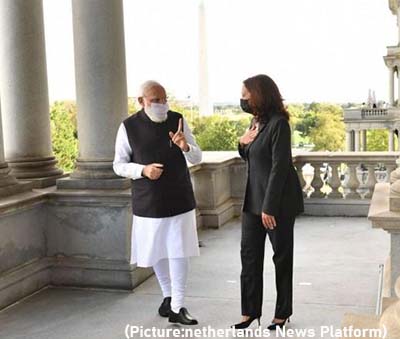 Harris praised India for stepping forward to help other countries with vaccines at the outset of the pandemic. Prime Minister Modi praised the leadership of the new administration in overcoming challenges besetting the country.
Harris praised India for stepping forward to help other countries with vaccines at the outset of the pandemic. Prime Minister Modi praised the leadership of the new administration in overcoming challenges besetting the country.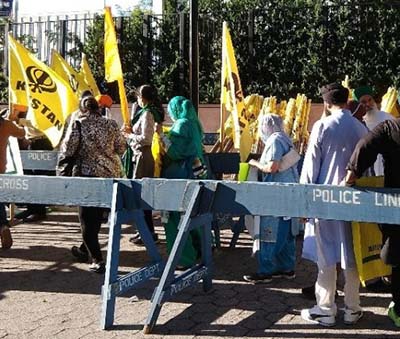 The rally was sponsored by 21 organizations under the banner of Coalition to Stop Genocide in India, including Ambedkar International Center, Ambedkar King Study Circle, Black Lives Matter, Coalition Against Fascism in India, Dalit Solidarity Forum, New York City Democratic Socialists’ Racial Justice Working Group, Federation of Indian American Christian Organizations of North America, Hindus for Human Rights, Indian American Muslim Council, India Civil Watch International, International Commission for Dalit Rights, Jewish Voice for Peace, MICAH Faith Institute, Muslim Community Network, National Coalition against Caste Discrimination in the USA, NY Sikh Council, New York State Council of Churches, SALAM, Students Against Hindutva Ideology, and Voices Against Fascism in India.
The rally was sponsored by 21 organizations under the banner of Coalition to Stop Genocide in India, including Ambedkar International Center, Ambedkar King Study Circle, Black Lives Matter, Coalition Against Fascism in India, Dalit Solidarity Forum, New York City Democratic Socialists’ Racial Justice Working Group, Federation of Indian American Christian Organizations of North America, Hindus for Human Rights, Indian American Muslim Council, India Civil Watch International, International Commission for Dalit Rights, Jewish Voice for Peace, MICAH Faith Institute, Muslim Community Network, National Coalition against Caste Discrimination in the USA, NY Sikh Council, New York State Council of Churches, SALAM, Students Against Hindutva Ideology, and Voices Against Fascism in India.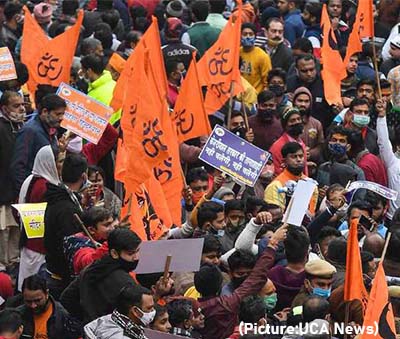 Located in western Madhya Pradesh, bordering Baroda, this district had witnessed similar unrest when Azad Prem Singh, a local leader of Vishwa Hindu Parishad (VHP) or World Hindu Council, had demanded the closure of all churches in the area earlier this year. Although Singh focused on Jhabua and surrounding tribal-dominated districts, the continued escalation of communal threats could have repercussions across the country, particularly in states like Madhya Pradesh which have enacted the anti-conversions laws.
Located in western Madhya Pradesh, bordering Baroda, this district had witnessed similar unrest when Azad Prem Singh, a local leader of Vishwa Hindu Parishad (VHP) or World Hindu Council, had demanded the closure of all churches in the area earlier this year. Although Singh focused on Jhabua and surrounding tribal-dominated districts, the continued escalation of communal threats could have repercussions across the country, particularly in states like Madhya Pradesh which have enacted the anti-conversions laws.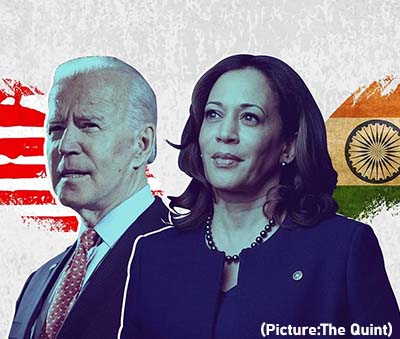 FIACONA has urged the President Biden and Vice President Harris “to be more direct and explicit in expressing that India should not and could not afford to go down the path of religious nationalism at the expense of pluralist democratic principles that values Christian and other religious segments of the population. Should Modi and his party choose to continue down this path of religious nationalism despite warnings from leaders of the free world, there is no reason to assume that India would end up any better than Pakistan, Sri Lanka, or Myanmar in that region, thus jeopardizing the stability and commerce in the Indo-Pacific region.”
FIACONA has urged the President Biden and Vice President Harris “to be more direct and explicit in expressing that India should not and could not afford to go down the path of religious nationalism at the expense of pluralist democratic principles that values Christian and other religious segments of the population. Should Modi and his party choose to continue down this path of religious nationalism despite warnings from leaders of the free world, there is no reason to assume that India would end up any better than Pakistan, Sri Lanka, or Myanmar in that region, thus jeopardizing the stability and commerce in the Indo-Pacific region.” He added, “Modi and Biden will review the robust and multifaceted ties between the India and the US. They will also deliberate on ways to further enrich India-US global partnership.”
He added, “Modi and Biden will review the robust and multifaceted ties between the India and the US. They will also deliberate on ways to further enrich India-US global partnership.”  Modi will then travel to New York, where he will address the 76th session of the United Nations General Assembly (UNGA) on Saturday morning. On September 25, Mr. Modi is scheduled to be the first speaker at the U.N. The theme for the general debate is: “Building resilience through hope to recover from COVID-19, rebuild sustainably, respond to the needs of the planet, respect the rights of people and revitalize the United Nations.”
Modi will then travel to New York, where he will address the 76th session of the United Nations General Assembly (UNGA) on Saturday morning. On September 25, Mr. Modi is scheduled to be the first speaker at the U.N. The theme for the general debate is: “Building resilience through hope to recover from COVID-19, rebuild sustainably, respond to the needs of the planet, respect the rights of people and revitalize the United Nations.” “As of today, nearly 5,500 Indian peacekeepers are deployed across nine UN missions,” she said. India takes pride in the fact that the first-ever all-women peacekeeping contingent was from India and stationed in Liberia, Lekhi added. “Due to their dedication, professionalism and motivation, the all-female FPU proved to be strong, visible role models, gaining world-wide attention and illustrating the significant contribution that women can make towards global peace and security.” She said that UN Peacekeeping Missions have been playing an important role in bringing about peace and stability in countries of deployment, despite numerous operational challenges. “One of the major operational challenges that continue to hamper peacekeeping operations has been the transition phase from peacekeeping to peacebuilding,” Lekhi noted.
“As of today, nearly 5,500 Indian peacekeepers are deployed across nine UN missions,” she said. India takes pride in the fact that the first-ever all-women peacekeeping contingent was from India and stationed in Liberia, Lekhi added. “Due to their dedication, professionalism and motivation, the all-female FPU proved to be strong, visible role models, gaining world-wide attention and illustrating the significant contribution that women can make towards global peace and security.” She said that UN Peacekeeping Missions have been playing an important role in bringing about peace and stability in countries of deployment, despite numerous operational challenges. “One of the major operational challenges that continue to hamper peacekeeping operations has been the transition phase from peacekeeping to peacebuilding,” Lekhi noted. This will be Modi’s first in-person meeting with Biden. The two have met virtually on at least three occasions — the Quad summit in March, the climate change summit in April, and the G-7 summit in June this year. Modi was supposed to travel to the UK for the G-7 summit where he could have met Biden, but had to cancel the trip due to the second Covid-19 wave across India. With the situation in Afghanistan unfolding rapidly, Modi’s visit is significant. Besides meeting Biden, he is expected to have important meetings with the top echelons of the US administration.
This will be Modi’s first in-person meeting with Biden. The two have met virtually on at least three occasions — the Quad summit in March, the climate change summit in April, and the G-7 summit in June this year. Modi was supposed to travel to the UK for the G-7 summit where he could have met Biden, but had to cancel the trip due to the second Covid-19 wave across India. With the situation in Afghanistan unfolding rapidly, Modi’s visit is significant. Besides meeting Biden, he is expected to have important meetings with the top echelons of the US administration. How we did this In 2019, roughly half of Hindu voters (49%) supported the BJP, giving the party a majority in the Lok Sabha – India’s lower house of parliament – and allowing Prime Minister Narendra Modi a
How we did this In 2019, roughly half of Hindu voters (49%) supported the BJP, giving the party a majority in the Lok Sabha – India’s lower house of parliament – and allowing Prime Minister Narendra Modi a  Tharoor, who attended the court proceedings virtually, thanked the court for discharging him of all offenses. “It had been seven and half years and it was a torture. I’m so grateful,” he said. Tharoor had been accused of subjecting his late wife to cruelty and abetting her suicide by Delhi Police, which had filed a detailed chargesheet in the matter. Pushkar’s body was discovered in a room of a five-star hotel in the capital on January 17, 2014. An FIR was registered by police a year later, on January 1, 2015, against unknown persons for murder. Tharoor was later booked under
Tharoor, who attended the court proceedings virtually, thanked the court for discharging him of all offenses. “It had been seven and half years and it was a torture. I’m so grateful,” he said. Tharoor had been accused of subjecting his late wife to cruelty and abetting her suicide by Delhi Police, which had filed a detailed chargesheet in the matter. Pushkar’s body was discovered in a room of a five-star hotel in the capital on January 17, 2014. An FIR was registered by police a year later, on January 1, 2015, against unknown persons for murder. Tharoor was later booked under  Soon after he unfurled the national flag to mark nation’s 75th Independence Day at the historic Red Fort here, Modi addressed the nation, saying the infrastructure plan will create job opportunities for millions of Indian youth. “It will help local manufacturers turn globally competitive and also develop possibilities of new future economic zones in the country,” he said.
Soon after he unfurled the national flag to mark nation’s 75th Independence Day at the historic Red Fort here, Modi addressed the nation, saying the infrastructure plan will create job opportunities for millions of Indian youth. “It will help local manufacturers turn globally competitive and also develop possibilities of new future economic zones in the country,” he said. India decided to focus on all aspects of maritime security in a holistic manner as one of its signature events during its current presidency of the UNSC during August. India took a responsible yet consensus-building approach by initiating consultations amongst all UNSC members from several months in advance. A concept note was prepared that incorporated ideas of all.
India decided to focus on all aspects of maritime security in a holistic manner as one of its signature events during its current presidency of the UNSC during August. India took a responsible yet consensus-building approach by initiating consultations amongst all UNSC members from several months in advance. A concept note was prepared that incorporated ideas of all. Since the issue relating to the Farmer’s plight was central to the concerns of the Indian diaspora which had gathered, this prohibition would prevent them from venting their sentiments and showing support to the cause of the farmers, as a result of which it left them no choice but to stay put at the location and voice their bitter disappointment over the unfair and undemocratic imposition of conditions which prevented them from participating in celebrating the joyous occasion of the Independence Day of India while at the same time expressing serious concern on the inaction of the sitting government to resolve the issue.
Since the issue relating to the Farmer’s plight was central to the concerns of the Indian diaspora which had gathered, this prohibition would prevent them from venting their sentiments and showing support to the cause of the farmers, as a result of which it left them no choice but to stay put at the location and voice their bitter disappointment over the unfair and undemocratic imposition of conditions which prevented them from participating in celebrating the joyous occasion of the Independence Day of India while at the same time expressing serious concern on the inaction of the sitting government to resolve the issue. Chief Justice of India N V Ramana who, along with Justice Surya Kant, was hearing eight petitions seeking an independent probe into the matter, said: “No doubt, the allegations are serious, if the reports are true.” The Chief Justice of India’s Supreme Court, while stating that he was not getting into facts of each and every case, said: “You know there are provisions under the Telegraph Act, IT Act etc to file complaints. These are the things which bother us.”
Chief Justice of India N V Ramana who, along with Justice Surya Kant, was hearing eight petitions seeking an independent probe into the matter, said: “No doubt, the allegations are serious, if the reports are true.” The Chief Justice of India’s Supreme Court, while stating that he was not getting into facts of each and every case, said: “You know there are provisions under the Telegraph Act, IT Act etc to file complaints. These are the things which bother us.”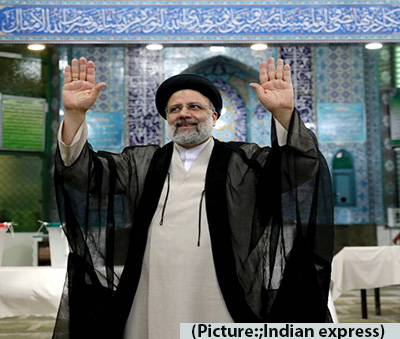 Iran appears eager to reciprocate. When Jaishankar was in Tehran last month on his way to Moscow, Raisi received him—making him the first foreign minister of any country to get that opportunity—and signaled Iran’s interest in stepping up cooperation with India. And in recent weeks, New Delhi and Tehran have
Iran appears eager to reciprocate. When Jaishankar was in Tehran last month on his way to Moscow, Raisi received him—making him the first foreign minister of any country to get that opportunity—and signaled Iran’s interest in stepping up cooperation with India. And in recent weeks, New Delhi and Tehran have  The action came after the National Commission for Protection of Child Rights (NCPCR) issued a notice to Twitter India, asking the social media platform to remove the tweet which revealed the identity of the rape victim.
The action came after the National Commission for Protection of Child Rights (NCPCR) issued a notice to Twitter India, asking the social media platform to remove the tweet which revealed the identity of the rape victim. India on Sunday assumed the presidency of the United Nations Security Council for the month of August and is set to organize key events in three major areas of maritime security, peacekeeping and counter-terrorism.
India on Sunday assumed the presidency of the United Nations Security Council for the month of August and is set to organize key events in three major areas of maritime security, peacekeeping and counter-terrorism. However, this does not give justice to hundreds of Christians and other minorities who sacrificed their lives due to the quest of the ruling party to declare India as a Hindu state. The poor departed souls must have been churning in their graves when they hear such statements. The injustices suffered by the 84-year-old Fr. Stan Sway alone should have been reason enough for Mr. Blinken to have been more cautious in his statements about human rights and respect for democratic principles by the government of India.
However, this does not give justice to hundreds of Christians and other minorities who sacrificed their lives due to the quest of the ruling party to declare India as a Hindu state. The poor departed souls must have been churning in their graves when they hear such statements. The injustices suffered by the 84-year-old Fr. Stan Sway alone should have been reason enough for Mr. Blinken to have been more cautious in his statements about human rights and respect for democratic principles by the government of India. Edited by the Delhi-based veteran journalist and foreign policy analystTarunBasu, the evocative collection titled, “Kamala Harris and the Rise of Indian Americans,” captures the rise of the Indians in the US across domains by exceptional achievers like Shashi Tharoor, a former UN public servant-turned Indian politician, and top diplomats like TP Sreenivasan and Arun K Singh. Sixteen eminent journalists, business leaders and scholars have contributed essays to the timely and priceless volume, which charts the community’s growing and influential political engagement. The book was released July 15 by New Delhi-based publisher Wisdom Tree and is available in the U.S. via Amazon. Basu describes the book as an “eclectic amalgam of perspectives on the emerging Indian-American story.”
Edited by the Delhi-based veteran journalist and foreign policy analystTarunBasu, the evocative collection titled, “Kamala Harris and the Rise of Indian Americans,” captures the rise of the Indians in the US across domains by exceptional achievers like Shashi Tharoor, a former UN public servant-turned Indian politician, and top diplomats like TP Sreenivasan and Arun K Singh. Sixteen eminent journalists, business leaders and scholars have contributed essays to the timely and priceless volume, which charts the community’s growing and influential political engagement. The book was released July 15 by New Delhi-based publisher Wisdom Tree and is available in the U.S. via Amazon. Basu describes the book as an “eclectic amalgam of perspectives on the emerging Indian-American story.”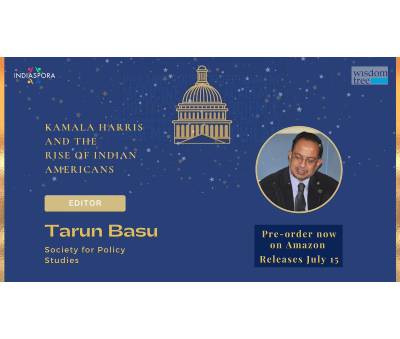 Basu has maintained a keen interest in the accomplishments of Indians abroad and has kept close touch with the community. The purpose of this anthology of essays edited by him is to bring to the global eye the unfolding saga of four million Indians in the United States. Indian Americans currently are just 1% of the US population but are expected to rise to 2% by 2030. Portraying the rise of the Indian American physicians as a strong and influential force in the United States, Ajay Ghosh chronicling their long journey to the United States and their success story, in a Chapter titled, “Physicians of Indian Heritage: America’s Healers” takes the readers to the times of Dr. AnandibaiJoshi, the first documented physician of Indian origin who had landed on the shores of the United States in 1883.
Basu has maintained a keen interest in the accomplishments of Indians abroad and has kept close touch with the community. The purpose of this anthology of essays edited by him is to bring to the global eye the unfolding saga of four million Indians in the United States. Indian Americans currently are just 1% of the US population but are expected to rise to 2% by 2030. Portraying the rise of the Indian American physicians as a strong and influential force in the United States, Ajay Ghosh chronicling their long journey to the United States and their success story, in a Chapter titled, “Physicians of Indian Heritage: America’s Healers” takes the readers to the times of Dr. AnandibaiJoshi, the first documented physician of Indian origin who had landed on the shores of the United States in 1883.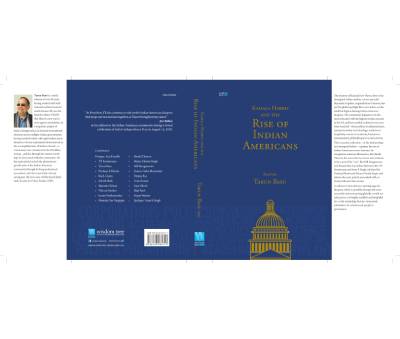 “The nomination — and subsequent election — of the U.S.-born Indian origin Kamala Harris put the media spotlight on the small, but respected and high-achieving Indian American community,” writes Basu in his preface. “It is a fascinating and inspiring story of how an immigrant population from a developing country, with low education levels, became the most educated, highest-earning ethnic community in the world’s most advanced nation in almost a single generation,” he said, noting that Indian Americans have made their mark in almost every field, from the traditional trifecta of science, engineering and medicine, to the arts, academia, philanthropy, and, increasingly, politics.
“The nomination — and subsequent election — of the U.S.-born Indian origin Kamala Harris put the media spotlight on the small, but respected and high-achieving Indian American community,” writes Basu in his preface. “It is a fascinating and inspiring story of how an immigrant population from a developing country, with low education levels, became the most educated, highest-earning ethnic community in the world’s most advanced nation in almost a single generation,” he said, noting that Indian Americans have made their mark in almost every field, from the traditional trifecta of science, engineering and medicine, to the arts, academia, philanthropy, and, increasingly, politics.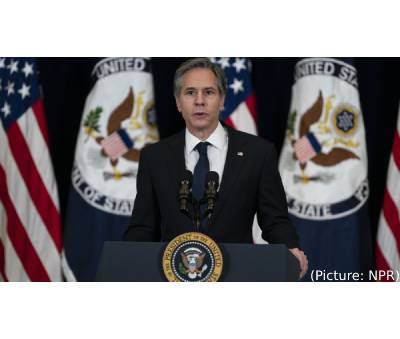 Blinken arrived in India on July 27th to discuss strengthening Indo-Pacific engagement, seen as a counter to China, as well as New Delhi’s recent human rights record and other issues. Blinken’s visit included meetings with Prime Minister Narendra Modi and senior officials on Wednesday, and was held just days after his No. 2 diplomat, Wendy Sherman, was in China for
Blinken arrived in India on July 27th to discuss strengthening Indo-Pacific engagement, seen as a counter to China, as well as New Delhi’s recent human rights record and other issues. Blinken’s visit included meetings with Prime Minister Narendra Modi and senior officials on Wednesday, and was held just days after his No. 2 diplomat, Wendy Sherman, was in China for 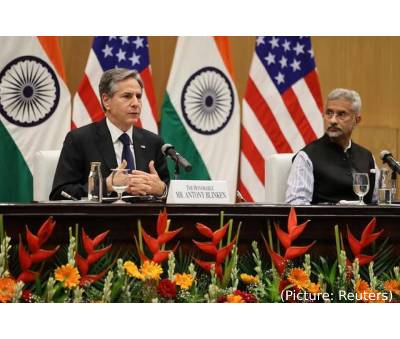 Jaishankar said he made three points to Blinken, including the fact that the “quest for a more perfect union applies as much to the Indian democracy as it does to the American one”.Ahead of Blinken’s visit, India’s
Jaishankar said he made three points to Blinken, including the fact that the “quest for a more perfect union applies as much to the Indian democracy as it does to the American one”.Ahead of Blinken’s visit, India’s 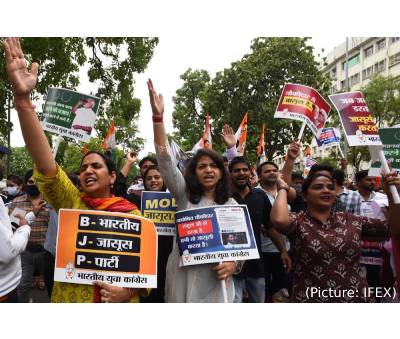 Malinowski, who serves on the House Foreign Affairs and Homeland Security Committees, said NSO Group needs to come clean following
Malinowski, who serves on the House Foreign Affairs and Homeland Security Committees, said NSO Group needs to come clean following 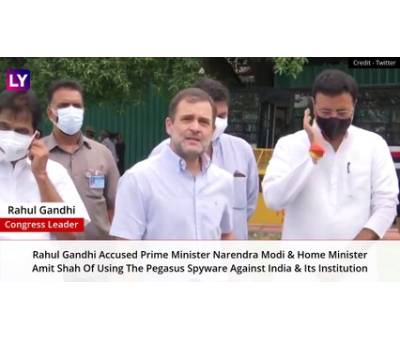 Pegasus took center stage in Parliament, leading to repeated adjournments of both Houses Gandhi’s name
Pegasus took center stage in Parliament, leading to repeated adjournments of both Houses Gandhi’s name 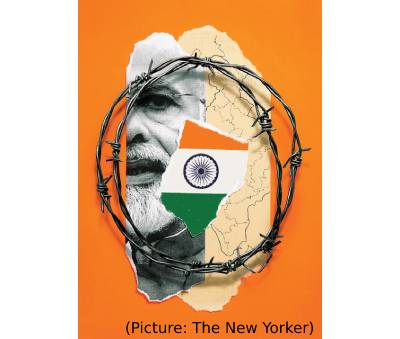 The Biden administration has condemned the harassment and ‘extrajudicial surveillance’ of journalists and others in reaction to reports published by a consortium of news websites that
The Biden administration has condemned the harassment and ‘extrajudicial surveillance’ of journalists and others in reaction to reports published by a consortium of news websites that 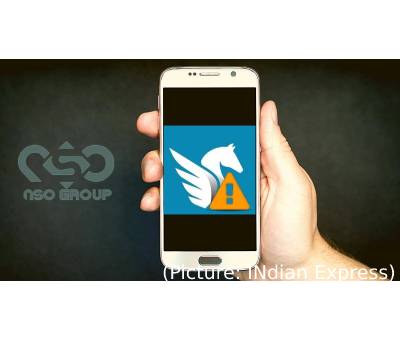 New Delhi has hostile relations with China and Pakistan at present, and their diplomats are under close watch, but it is significant that the list included several countries that India has very friendly ties with as well. They include a woman who made sexual harassment allegations against India’s former chief justice, as well as Tibetan Buddhist clerics, Pakistani diplomats and Chinese journalists, the reports said. More than 50,000 phone numbers of citizens clustered mainly in Azerbaijan, Bahrain, Hungary, India, Kazakhstan, Mexico, Morocco, Rwanda, Saudi Arabia and the United Arab Emirates have been studied as a part of the international collaboration by NGOs and media organisations investigating phone surveillance using Pegasus.
New Delhi has hostile relations with China and Pakistan at present, and their diplomats are under close watch, but it is significant that the list included several countries that India has very friendly ties with as well. They include a woman who made sexual harassment allegations against India’s former chief justice, as well as Tibetan Buddhist clerics, Pakistani diplomats and Chinese journalists, the reports said. More than 50,000 phone numbers of citizens clustered mainly in Azerbaijan, Bahrain, Hungary, India, Kazakhstan, Mexico, Morocco, Rwanda, Saudi Arabia and the United Arab Emirates have been studied as a part of the international collaboration by NGOs and media organisations investigating phone surveillance using Pegasus.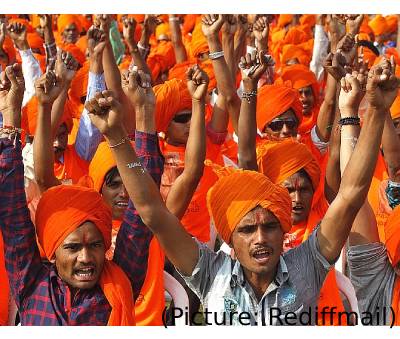 IAMC this week led an initiative to have a Joint Resolution approved at the summit that also calls for the State Department to designate India a CPC. The resolution was supported by more than 30 signatories and is being transmitted to the office of Secretary of State Antony Blinken. Ms. Bhargava pointed out that the Citizenship Amendment Act and the National Register of Citizens are limiting or eliminating pathways for Muslims to be able to demonstrate their citizenship, which can lead to them being wrongfully detained, deported, or worse, rendered stateless. With those laws, India is acting much like Myanmar, in how the latter systematically discriminated against the Rohingyas leading up to their genocide.
IAMC this week led an initiative to have a Joint Resolution approved at the summit that also calls for the State Department to designate India a CPC. The resolution was supported by more than 30 signatories and is being transmitted to the office of Secretary of State Antony Blinken. Ms. Bhargava pointed out that the Citizenship Amendment Act and the National Register of Citizens are limiting or eliminating pathways for Muslims to be able to demonstrate their citizenship, which can lead to them being wrongfully detained, deported, or worse, rendered stateless. With those laws, India is acting much like Myanmar, in how the latter systematically discriminated against the Rohingyas leading up to their genocide.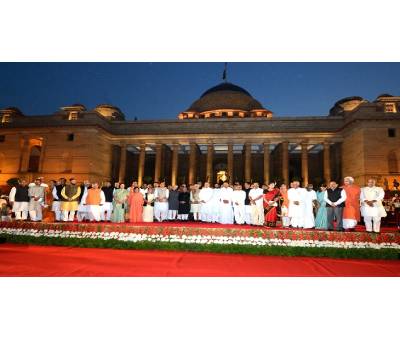 Prime Minister Narendra Modi
Prime Minister Narendra Modi 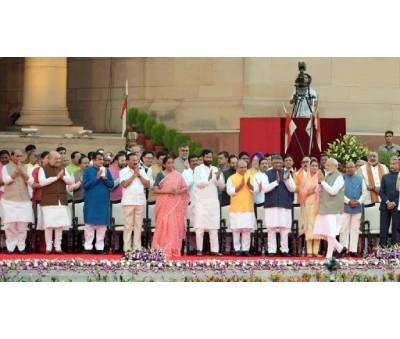 The Nearly 400 million Muslim population in India has a single Member representing the community in the Hindutva Ministry of Prime Minister Modi. And the Christian community is not represented. With Prime Minister Narendra Modi pledging ‘sabka saath, sabka vikas and sabka vishwas’ mantra, his cabinet’s lone Muslim face Mukhtar Abbas Naqvi will have the responsibility of winning the hearts of minorities and taking forward the ‘development without appeasement’ policy.
The Nearly 400 million Muslim population in India has a single Member representing the community in the Hindutva Ministry of Prime Minister Modi. And the Christian community is not represented. With Prime Minister Narendra Modi pledging ‘sabka saath, sabka vikas and sabka vishwas’ mantra, his cabinet’s lone Muslim face Mukhtar Abbas Naqvi will have the responsibility of winning the hearts of minorities and taking forward the ‘development without appeasement’ policy.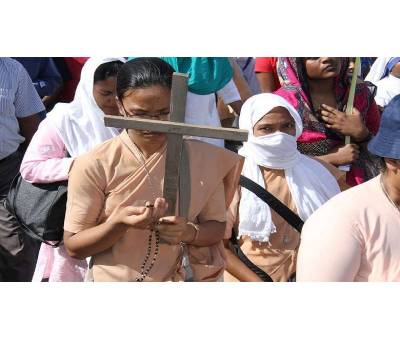 Two North Indian states Chhattisgarh and Jharkhand have recorded 22 incidents of violence against Christians in these six months followed by 19 in Uttar Pradesh and 17 in Karnataka. Other states which are witnessing violence against Christians for their faith are: Madhya Pradesh (15), Odisha (12), Maharashtra (9), Tamil Nadu (6), Punjab (6), Bihar (6), Andhra Pradesh (4), Uttarakhand (3), Delhi (3), Haryana (2), Gujarat (2), Telangana (1), West Bengal (1), Assam (1) and Rajasthan (1). Over one thousand (1137) calls were attended to at UCF helpline number and provided much needed solace to them through advocacy and assisting in reaching their grievances to the concerned authorities. Through these interventions the team could manage to obtain release of 84 persons from detention. Also 29 places of worship were reopened or continue to have prayer services. But, sadly, as always 18 FIRs could only be registered against the violence perpetrators.
Two North Indian states Chhattisgarh and Jharkhand have recorded 22 incidents of violence against Christians in these six months followed by 19 in Uttar Pradesh and 17 in Karnataka. Other states which are witnessing violence against Christians for their faith are: Madhya Pradesh (15), Odisha (12), Maharashtra (9), Tamil Nadu (6), Punjab (6), Bihar (6), Andhra Pradesh (4), Uttarakhand (3), Delhi (3), Haryana (2), Gujarat (2), Telangana (1), West Bengal (1), Assam (1) and Rajasthan (1). Over one thousand (1137) calls were attended to at UCF helpline number and provided much needed solace to them through advocacy and assisting in reaching their grievances to the concerned authorities. Through these interventions the team could manage to obtain release of 84 persons from detention. Also 29 places of worship were reopened or continue to have prayer services. But, sadly, as always 18 FIRs could only be registered against the violence perpetrators.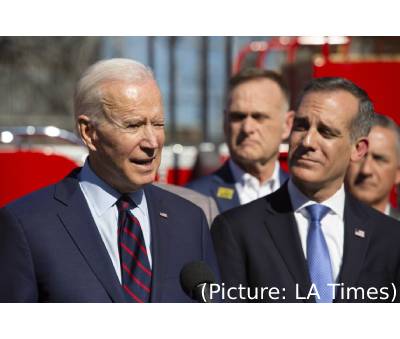 On accepting the nomination Garcetti posted a statement on the city’s website: “I love Los Angeles and will always be an Angeleno. I want you to know that every day I am your mayor, I will continue to lead this city like it is my first day on the job, with passion, focus, and determination. I have committed my life to service –– as an activist, as a teacher, as a naval officer, as a public servant and, if confirmed, next as an ambassador. Part of that commitment means that when your nation calls, you answer that call. And should I be confirmed, I’ll bring this same energy, commitment, and love for this city to my new role, and will forge partnerships and connections that will help Los Angeles.”
On accepting the nomination Garcetti posted a statement on the city’s website: “I love Los Angeles and will always be an Angeleno. I want you to know that every day I am your mayor, I will continue to lead this city like it is my first day on the job, with passion, focus, and determination. I have committed my life to service –– as an activist, as a teacher, as a naval officer, as a public servant and, if confirmed, next as an ambassador. Part of that commitment means that when your nation calls, you answer that call. And should I be confirmed, I’ll bring this same energy, commitment, and love for this city to my new role, and will forge partnerships and connections that will help Los Angeles.”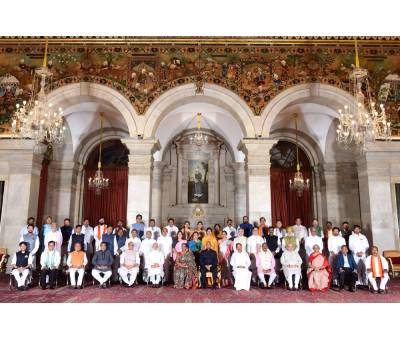 Hours after 43 leaders took oath as ministers in the RashtrapatiBhavan, the
Hours after 43 leaders took oath as ministers in the RashtrapatiBhavan, the 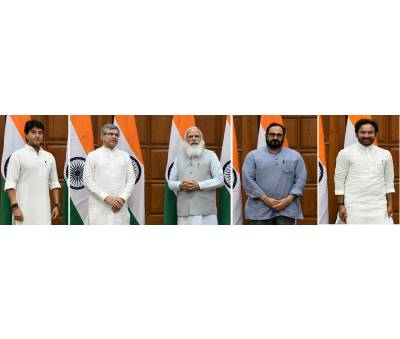 JyotiradityaScindia — one of the BJP’s high-profile acquisitions
JyotiradityaScindia — one of the BJP’s high-profile acquisitions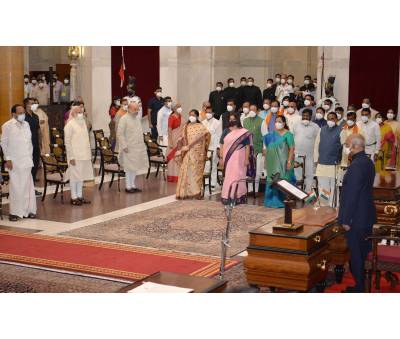 More than half of India’s reported 400,000 coronavirus deaths — the third most of any country — have occurred over the past two months as the delta variant of the virus tore through the nation and overwhelmed its already strained health system. New cases are on the decline after exceeding 400,000 a day in May, but authorities are preparing for another possible wave and are trying to ramp up vaccinations. The reshuffle also came after the defeat of Modi’s Hindu nationalist Bharatiya Janata Party in April elections in key West Bengal state, a test of its handling of the pandemic.
More than half of India’s reported 400,000 coronavirus deaths — the third most of any country — have occurred over the past two months as the delta variant of the virus tore through the nation and overwhelmed its already strained health system. New cases are on the decline after exceeding 400,000 a day in May, but authorities are preparing for another possible wave and are trying to ramp up vaccinations. The reshuffle also came after the defeat of Modi’s Hindu nationalist Bharatiya Janata Party in April elections in key West Bengal state, a test of its handling of the pandemic. Dr. Stanislaus D’Souza SJ, the Jesuit Provincial of India, said: “With a deep sense of pain, anguish and hope we have surrendered Fr Stan Swamy, aged 84, to his eternal abode.”The funeral service and Mass was led by Father Arun De Souza, Jesuit provincial of
Dr. Stanislaus D’Souza SJ, the Jesuit Provincial of India, said: “With a deep sense of pain, anguish and hope we have surrendered Fr Stan Swamy, aged 84, to his eternal abode.”The funeral service and Mass was led by Father Arun De Souza, Jesuit provincial of  Archbishop Felix Toppo of Ranchi and Auxiliary Bishop Theodore Mascarenhas. “The ‘caged parrot’ now sings in heaven but its blood is on our hands,” they wrote, “May the hand of God intervene to bring justice to all innocent victims of insensitivity, vindictiveness and injustice. We have lost Fr. Stan Swamy but we still hope in the God of justice,” they added.The Jamshedpur Jesuit Province, to which Father Swamy belonged, also expressed “a deep sense of pain, anguish and hope” at the death of the “servant in mission of justice and reconciliation”. In a Facebook post, Father Jerome Cutinha noted that the “author of life” had given Father Swamy “a mission to work among the Advasis [indigenous], Dalits [downtrodden] and other marginalized communities so that the poor may have life and life to the full, with dignity and honour”. “The Society of Jesus [Jesuits], at this moment, recommits itself to take forward the legacy of Fr. Stan in hits mission of justice and reconciliation,” Father Cutinha wrote.
Archbishop Felix Toppo of Ranchi and Auxiliary Bishop Theodore Mascarenhas. “The ‘caged parrot’ now sings in heaven but its blood is on our hands,” they wrote, “May the hand of God intervene to bring justice to all innocent victims of insensitivity, vindictiveness and injustice. We have lost Fr. Stan Swamy but we still hope in the God of justice,” they added.The Jamshedpur Jesuit Province, to which Father Swamy belonged, also expressed “a deep sense of pain, anguish and hope” at the death of the “servant in mission of justice and reconciliation”. In a Facebook post, Father Jerome Cutinha noted that the “author of life” had given Father Swamy “a mission to work among the Advasis [indigenous], Dalits [downtrodden] and other marginalized communities so that the poor may have life and life to the full, with dignity and honour”. “The Society of Jesus [Jesuits], at this moment, recommits itself to take forward the legacy of Fr. Stan in hits mission of justice and reconciliation,” Father Cutinha wrote. India’s caste system was officially abolished in 1950, but the 2,000-year-old social hierarchy imposed on people by birth still exists in many aspects of life. The caste system categorizes Hindus at birth, defining their place in society, what jobs they can do and who they can marry. In October last year, Swamy was arrested and charged under the country’s anti-terrorism laws, which critics have described as draconian.
India’s caste system was officially abolished in 1950, but the 2,000-year-old social hierarchy imposed on people by birth still exists in many aspects of life. The caste system categorizes Hindus at birth, defining their place in society, what jobs they can do and who they can marry. In October last year, Swamy was arrested and charged under the country’s anti-terrorism laws, which critics have described as draconian.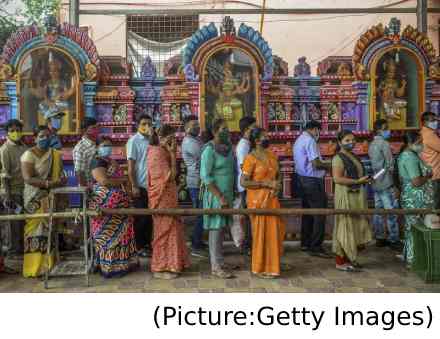 That’s a surprising position for the country that’s home to the world’s biggest vaccine manufacturer, the
That’s a surprising position for the country that’s home to the world’s biggest vaccine manufacturer, the 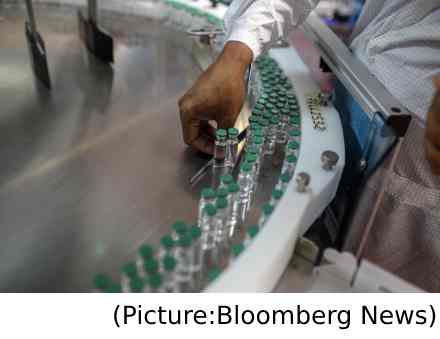 On June 21, India administered some
On June 21, India administered some  Los Angeles Mayor Eric Garcetti,50, is likely to be nominated as U.S. ambassador to India by President Biden. The Associated Press reported last week that Biden is
Los Angeles Mayor Eric Garcetti,50, is likely to be nominated as U.S. ambassador to India by President Biden. The Associated Press reported last week that Biden is  Garcetti’s popularity has slipped in recent years, and Black Lives Matter protesters had banged drums outside his official residence earlier this year to urge Biden not to choose Garcetti for a Cabinet position. Garcetti was overmatched by a crisis of homelessness that became a national embarrassment despite the massive jump in government spending to fight it. Many streets and sidewalks remain cratered and crumbling, despite his early pledge to make fixing them a cornerstone of his administration.In picking Garcetti, the president would be rewarding a loyalist who was one of his national campaign co-chairs, who served on the committee that vetted his pool of vice presidential contenders, and who served as one of several co-chairs for Biden’s inaugural committee.
Garcetti’s popularity has slipped in recent years, and Black Lives Matter protesters had banged drums outside his official residence earlier this year to urge Biden not to choose Garcetti for a Cabinet position. Garcetti was overmatched by a crisis of homelessness that became a national embarrassment despite the massive jump in government spending to fight it. Many streets and sidewalks remain cratered and crumbling, despite his early pledge to make fixing them a cornerstone of his administration.In picking Garcetti, the president would be rewarding a loyalist who was one of his national campaign co-chairs, who served on the committee that vetted his pool of vice presidential contenders, and who served as one of several co-chairs for Biden’s inaugural committee.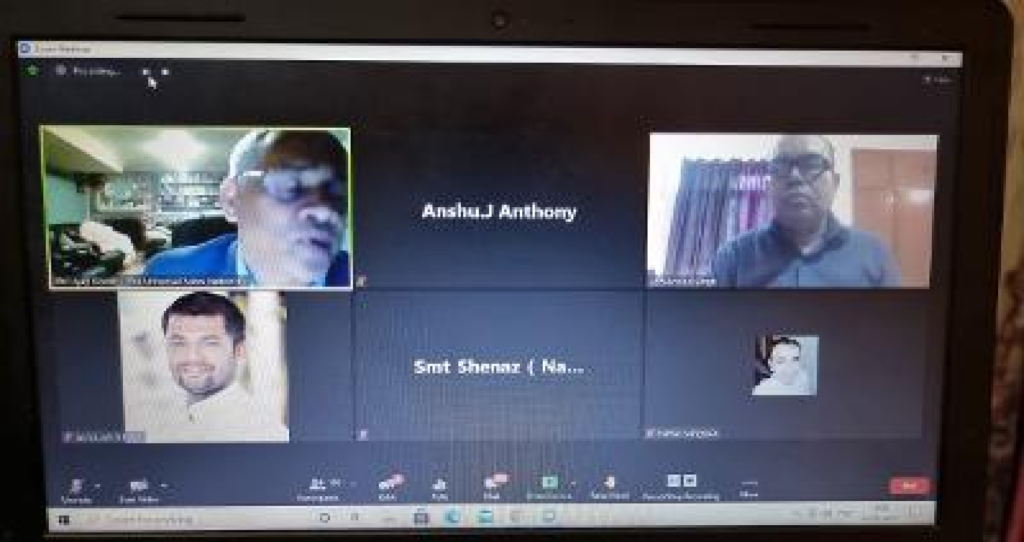 In January 2021, Modi declared at a
In January 2021, Modi declared at a 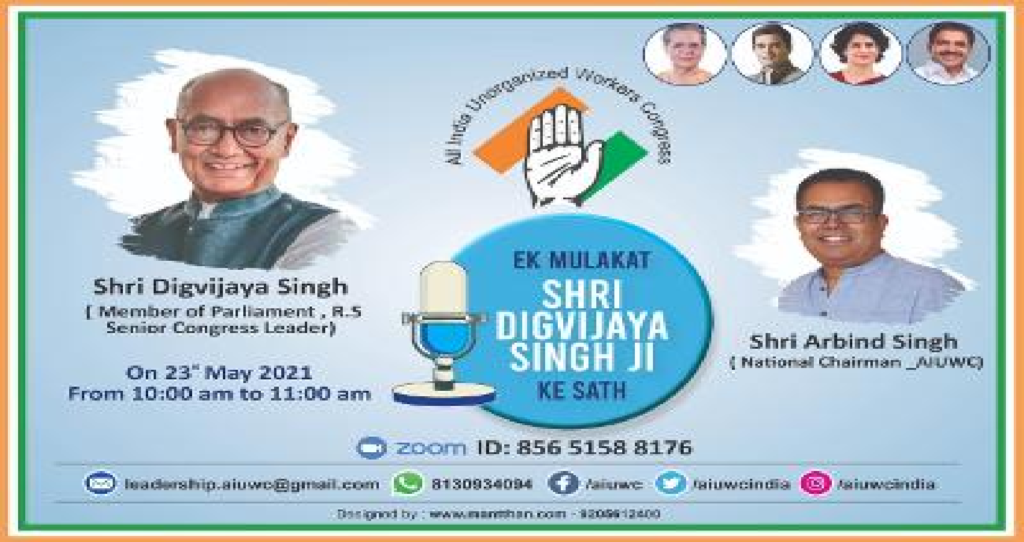 The sudden and abrupt lock down promulgated by Modi even before the 1st wave of the pandemic hit India caused enormous problems for millions of poor. It lies with the upper-middle-class Indians who were last year
The sudden and abrupt lock down promulgated by Modi even before the 1st wave of the pandemic hit India caused enormous problems for millions of poor. It lies with the upper-middle-class Indians who were last year 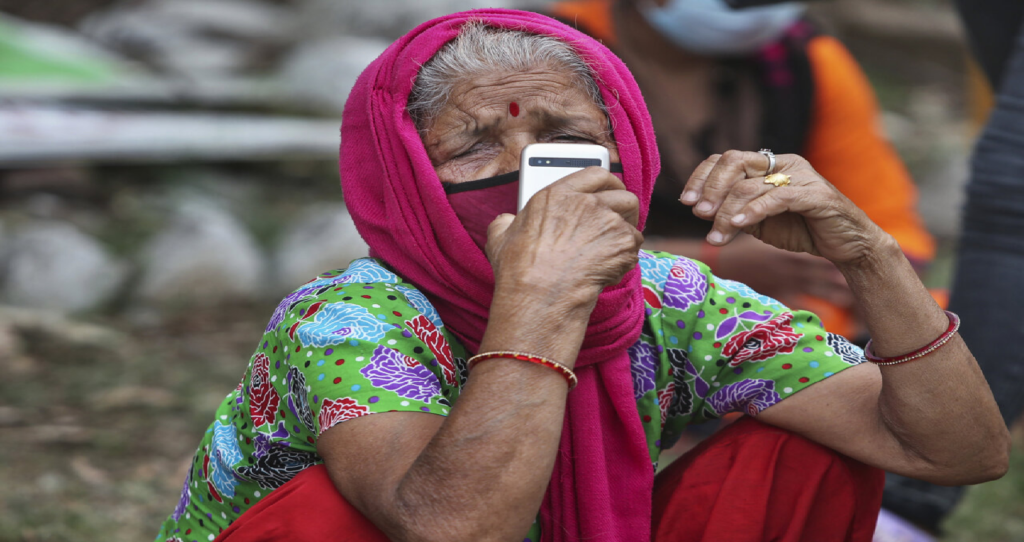 In January, Prime Minister Narendra Modi
In January, Prime Minister Narendra Modi 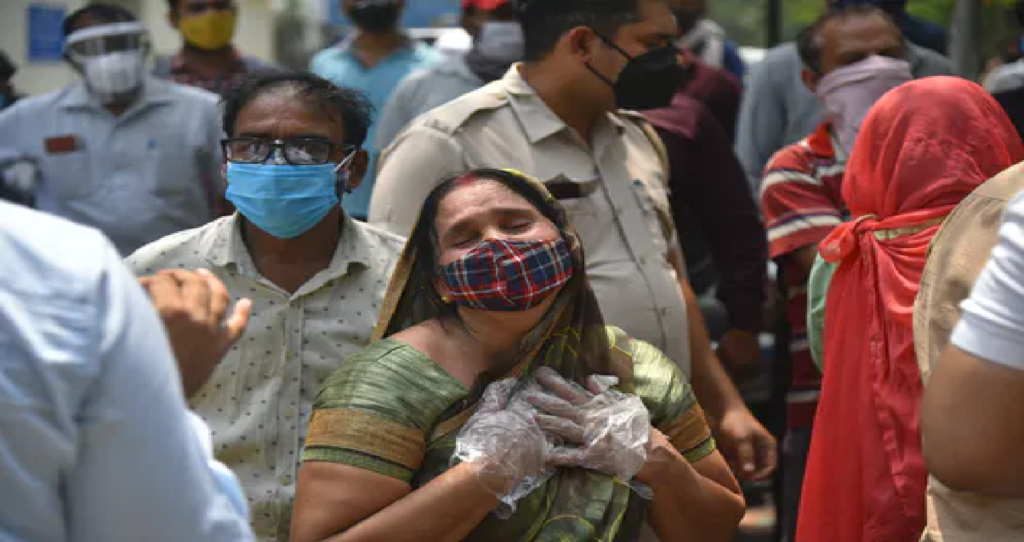 “Firstly, every NGO in the country had to set up an FCRA designated account at the main branch of State Bank of India in New Delhi to receive all foreign donations. Earlier, donations could be received in any bank where the NGO had a designated FCRA account.
“Firstly, every NGO in the country had to set up an FCRA designated account at the main branch of State Bank of India in New Delhi to receive all foreign donations. Earlier, donations could be received in any bank where the NGO had a designated FCRA account.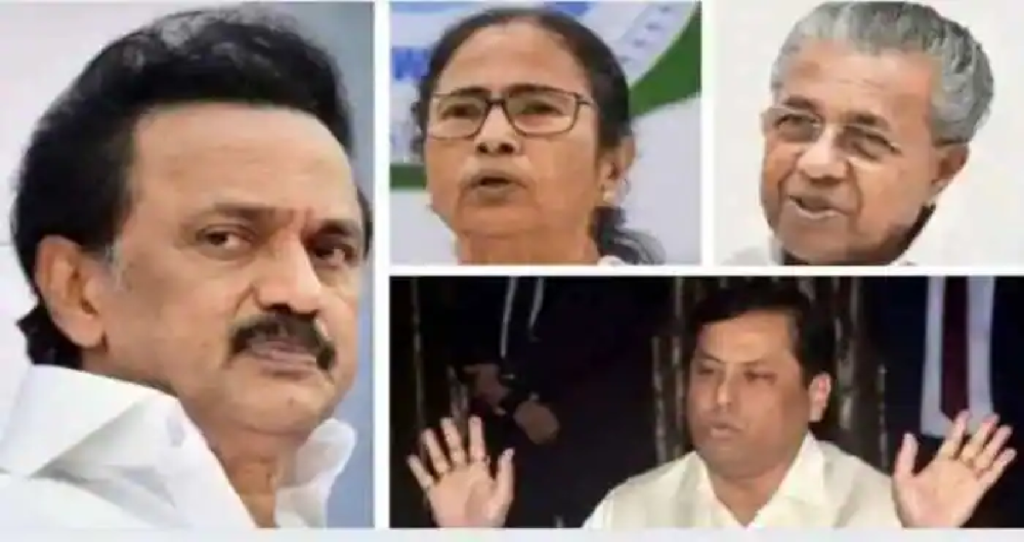 In West Bengal, incumbent Chief Minister Mamata Banerjee’s All India Trinamool Congress won around 72% of 292 seats up for grabs, while Modi’s Bharatiya Janata Party took 77, according to results posted on the
In West Bengal, incumbent Chief Minister Mamata Banerjee’s All India Trinamool Congress won around 72% of 292 seats up for grabs, while Modi’s Bharatiya Janata Party took 77, according to results posted on the 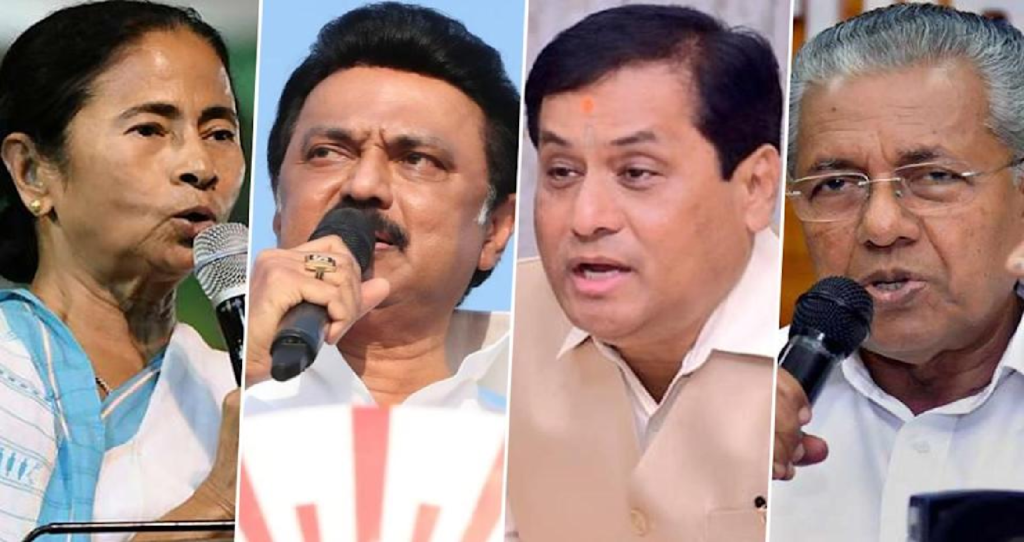 In a victory speech later Sunday, 66-year-old Banerjee said West Bengal’s “immediate challenge is to combat the Covid-19 and we are confident that we will win This victory has saved the humanity, the people of India. It’s the victory of India,” Banerjee, a fierce critic of Modi, added.
In a victory speech later Sunday, 66-year-old Banerjee said West Bengal’s “immediate challenge is to combat the Covid-19 and we are confident that we will win This victory has saved the humanity, the people of India. It’s the victory of India,” Banerjee, a fierce critic of Modi, added.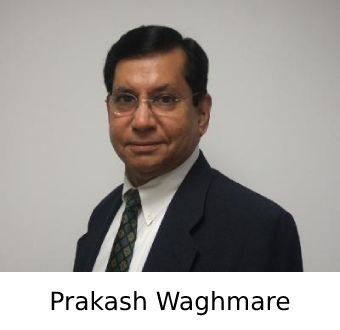 Covid-19 is a global phenomenon but in India it is being tossed around like a political football whose ultimate goal is, not only to project how the country is on the brink of ‘Armageddon’, but also, to emphasize how inept and insensitive the current administration is. The major players in this game are the opposition political parties and their surrogates. Scores of leading opposition political leaders who are now clamoring for vaccines, had earlier not only mocked the idea of vaccination, but also, had floated vigorous anti-vaccine campaign. The current shortage of ‘oxygen’ has everything to do with the lethargy of the State-govts. The Central-govt had sectioned 162 oxygen generating PSA plants for strategic areas across India but the States collectively set only 33 plants and blamed the Central-govt for their own ineptitude. Make no mistake, in this game, some national and international Medias are also involved. Instead of reporting positive inspiring stories, they mass-marketed unflattering, exaggerated or sometimes even fake stories. The international Media has converged on India’s plight as if it is the biggest calamity the world has ever witnessed. When China, the birthplace of Covid-19 and the global capital of misinformation, recently planted a mischievous tweet on the social-media, it was summarily condemned by a major news organization in U.S. We all know how a leading New York tabloid, couple of weeks back, used a picture of a roadside dead body from some gas leakage somewhere, to support their claim, ‘how the people in India are dying on the streets’. This is not an isolated incidence. Scandal-sniffing notorious British press isn’t less offensive either. The international media-cartel has never publicized the complicity of their own govts in the current crisis. As per WHO, 87% of vaccines have been cornered by high-income countries and only 0.2% of vaccines have gone to poor countries. The Indian ‘netizens’ who also now include numerous private TV channels, have proved themselves equal to so-called ‘yellow journalism’ by exposing all the falsification and putting it against rock-solid proofs. When, opposition parties are harping on the sorry conditions in the country, it is worth noting that none of their cadre or party-workers are seen anywhere helping out the masses. In their stark absence, the people have taken things into their own hands. At this moment, lot of caregiving is being done by numerous social or religious local organizations. All these organizations are collectively providing hundreds of thousands of meals to the needy people; setting up thousands of beds and acquiring necessary equipment & medications, where possible. Spearheading these efforts, nationwide, are RSS, VHP volunteers.
Covid-19 is a global phenomenon but in India it is being tossed around like a political football whose ultimate goal is, not only to project how the country is on the brink of ‘Armageddon’, but also, to emphasize how inept and insensitive the current administration is. The major players in this game are the opposition political parties and their surrogates. Scores of leading opposition political leaders who are now clamoring for vaccines, had earlier not only mocked the idea of vaccination, but also, had floated vigorous anti-vaccine campaign. The current shortage of ‘oxygen’ has everything to do with the lethargy of the State-govts. The Central-govt had sectioned 162 oxygen generating PSA plants for strategic areas across India but the States collectively set only 33 plants and blamed the Central-govt for their own ineptitude. Make no mistake, in this game, some national and international Medias are also involved. Instead of reporting positive inspiring stories, they mass-marketed unflattering, exaggerated or sometimes even fake stories. The international Media has converged on India’s plight as if it is the biggest calamity the world has ever witnessed. When China, the birthplace of Covid-19 and the global capital of misinformation, recently planted a mischievous tweet on the social-media, it was summarily condemned by a major news organization in U.S. We all know how a leading New York tabloid, couple of weeks back, used a picture of a roadside dead body from some gas leakage somewhere, to support their claim, ‘how the people in India are dying on the streets’. This is not an isolated incidence. Scandal-sniffing notorious British press isn’t less offensive either. The international media-cartel has never publicized the complicity of their own govts in the current crisis. As per WHO, 87% of vaccines have been cornered by high-income countries and only 0.2% of vaccines have gone to poor countries. The Indian ‘netizens’ who also now include numerous private TV channels, have proved themselves equal to so-called ‘yellow journalism’ by exposing all the falsification and putting it against rock-solid proofs. When, opposition parties are harping on the sorry conditions in the country, it is worth noting that none of their cadre or party-workers are seen anywhere helping out the masses. In their stark absence, the people have taken things into their own hands. At this moment, lot of caregiving is being done by numerous social or religious local organizations. All these organizations are collectively providing hundreds of thousands of meals to the needy people; setting up thousands of beds and acquiring necessary equipment & medications, where possible. Spearheading these efforts, nationwide, are RSS, VHP volunteers.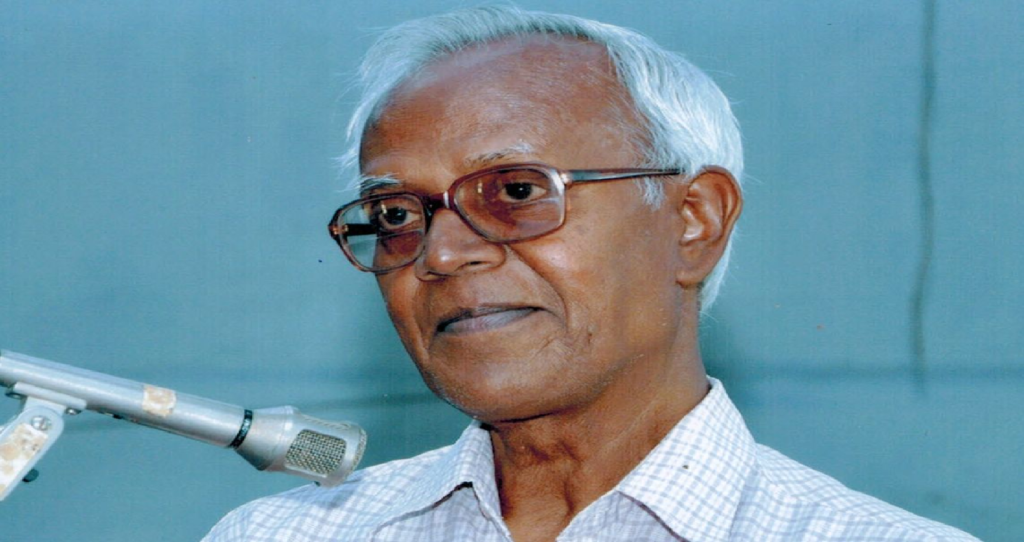 The activists accused in the case deny the charges against them. They include a prominent academic, a labor lawyer, a justifyist poet, a Jesuit priest and two singers. All are advocates for the rights of the country’s most disadvantaged communities and vocal opponents of the ruling party. Many of them have been jailed for nearly three years as they await trial.
The activists accused in the case deny the charges against them. They include a prominent academic, a labor lawyer, a justifyist poet, a Jesuit priest and two singers. All are advocates for the rights of the country’s most disadvantaged communities and vocal opponents of the ruling party. Many of them have been jailed for nearly three years as they await trial. Indian American Congressman Ro Khanna, while sharing a tweet from eminent public health expert Ashish K Jha, said, “India is in the throes of a horrendous COVID surge.
Indian American Congressman Ro Khanna, while sharing a tweet from eminent public health expert Ashish K Jha, said, “India is in the throes of a horrendous COVID surge.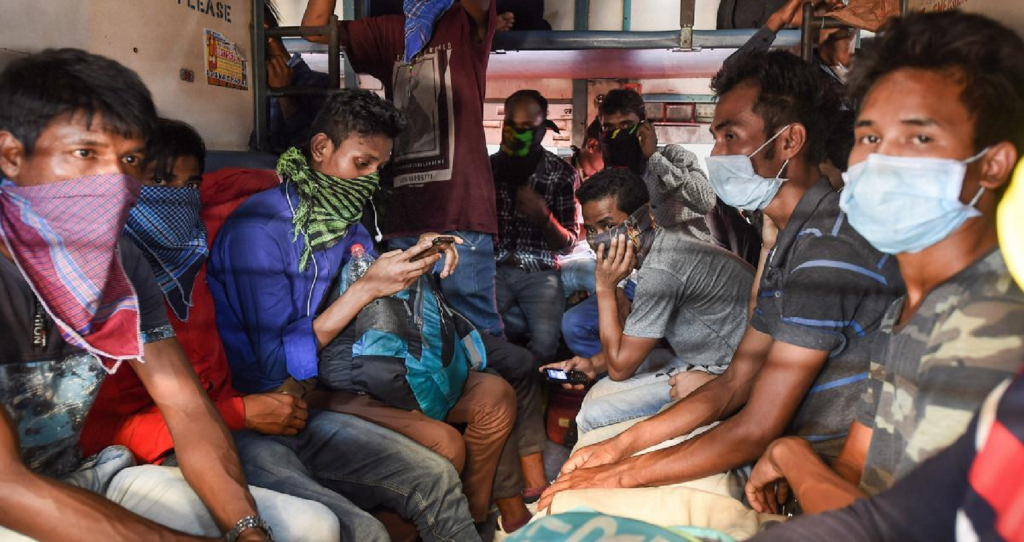 “India is in the ICU and those who put her there now spend their time trying to shift the blame. The change from ‘victory’ over Covid to gasping for oxygen began in the last week of January this year when the Prime Minister proudly declared that India had not only defeated the
“India is in the ICU and those who put her there now spend their time trying to shift the blame. The change from ‘victory’ over Covid to gasping for oxygen began in the last week of January this year when the Prime Minister proudly declared that India had not only defeated the 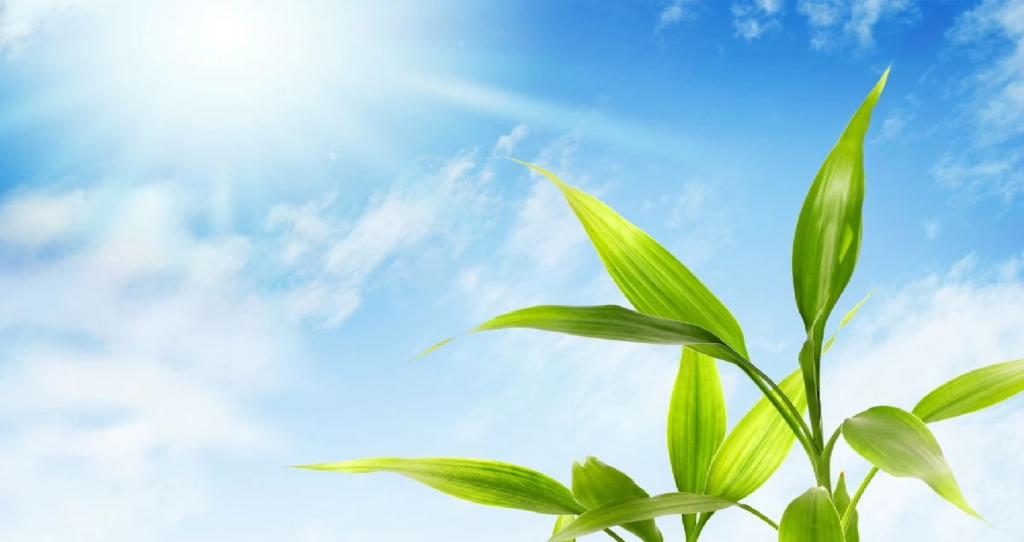 To help meet this goal, he said that the US will double by 2024 “our annual public climate development finance to developing countries compared to what we were providing during the second half of Obama-Biden administration”.
To help meet this goal, he said that the US will double by 2024 “our annual public climate development finance to developing countries compared to what we were providing during the second half of Obama-Biden administration”.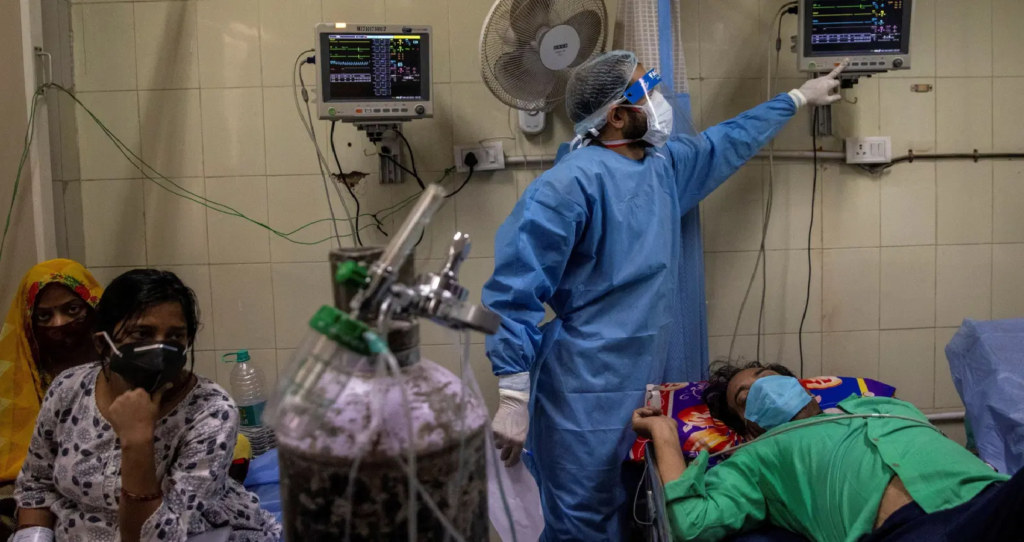 India has now recorded more than 15 million infections and more than 178,000 deaths. Experts agree that even these figures are likely undercounts. New Delhi imposed a weeklong lockdown Monday night to prevent the collapse of the Indian capital’s health system, which authorities said had been pushed to its limit amid an explosive surge in coronavirus cases.
India has now recorded more than 15 million infections and more than 178,000 deaths. Experts agree that even these figures are likely undercounts. New Delhi imposed a weeklong lockdown Monday night to prevent the collapse of the Indian capital’s health system, which authorities said had been pushed to its limit amid an explosive surge in coronavirus cases.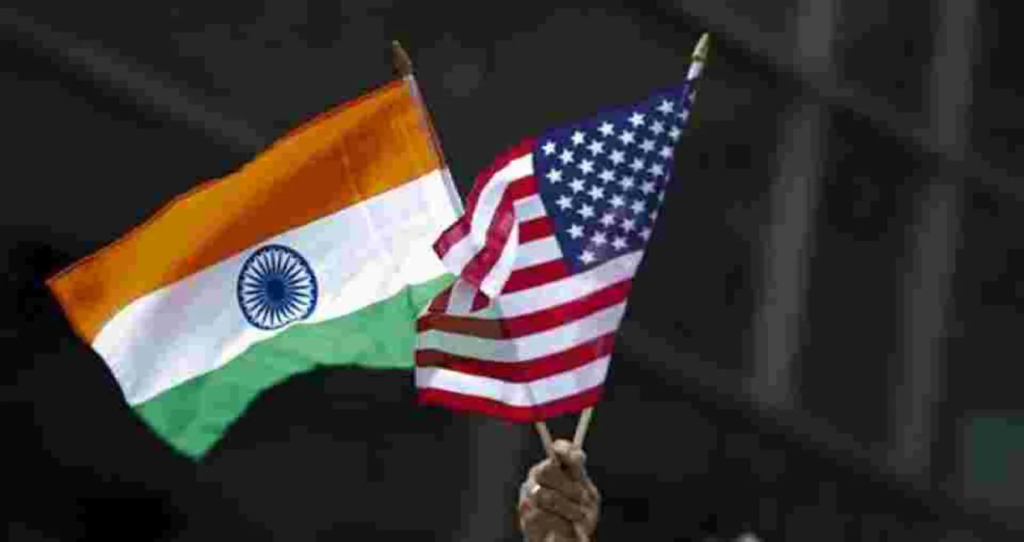 Responding to a question on criticism of India’s exports of Covid-19 vaccines amid growing domestic demand, Jaishankar noted that the vaccine being produced in India in the largest quantity – the AstraZeneca jab made by SII – is a “co-creation” and an international product. “Can I, on one hand, go round the world and say, guys, keep your supply chain flowing towards me, and by the way… I am asking you for raw material but I am not going to give you the vaccine?” he asked
Responding to a question on criticism of India’s exports of Covid-19 vaccines amid growing domestic demand, Jaishankar noted that the vaccine being produced in India in the largest quantity – the AstraZeneca jab made by SII – is a “co-creation” and an international product. “Can I, on one hand, go round the world and say, guys, keep your supply chain flowing towards me, and by the way… I am asking you for raw material but I am not going to give you the vaccine?” he asked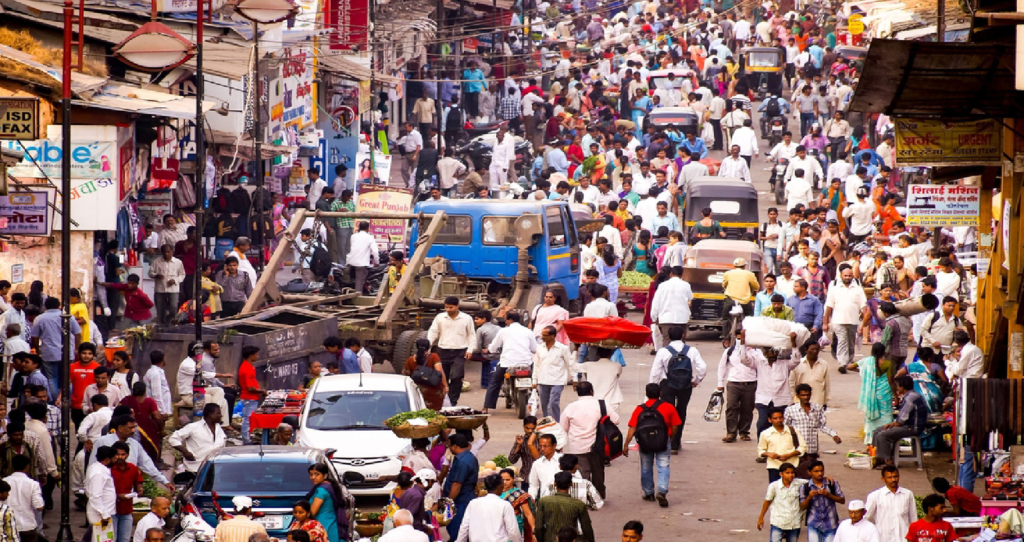 India cannot afford to fall behind in the vaccination race because the whole world now knows that the only way to defeat Covid-19 is by vaccinating as many people as possible, as soon as possible. So, when high officials in the Government of India declare that only those who ‘need’ vaccinations should be given them, they seem either to be covering up for the serious shortage of vaccines or to be totally removed from reality. Every government in the world today is centering its fight against the
India cannot afford to fall behind in the vaccination race because the whole world now knows that the only way to defeat Covid-19 is by vaccinating as many people as possible, as soon as possible. So, when high officials in the Government of India declare that only those who ‘need’ vaccinations should be given them, they seem either to be covering up for the serious shortage of vaccines or to be totally removed from reality. Every government in the world today is centering its fight against the 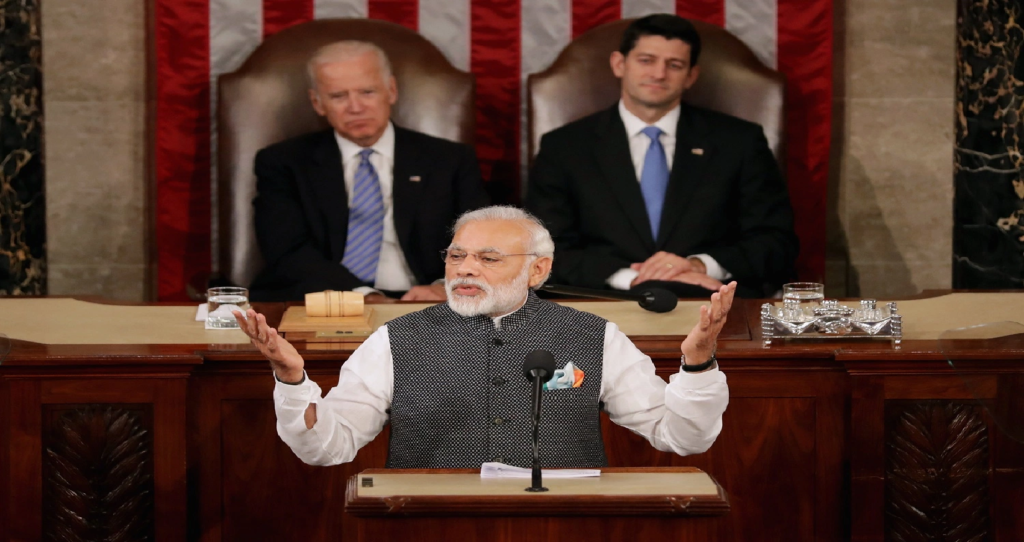 A leading think tank for science and technology policy has said as Washington seeks to counter a rising China, no nation is more important than India with its abundance of highly skilled technical professionals and strong political and cultural ties with the United States.
A leading think tank for science and technology policy has said as Washington seeks to counter a rising China, no nation is more important than India with its abundance of highly skilled technical professionals and strong political and cultural ties with the United States.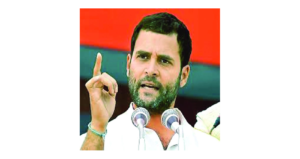 Rahul won his first election with an overwhelming margin of 2,90,853 votes — a testament to the faith placed by the people of his constituency in him. From the beginning, it was apparent that Rahul believed that our nation’s future lies with her people. Through the ebbs and flows of a decade-long political career, Rahul has held true to the very principles that won him the hearts of the people in his very first election.
Rahul won his first election with an overwhelming margin of 2,90,853 votes — a testament to the faith placed by the people of his constituency in him. From the beginning, it was apparent that Rahul believed that our nation’s future lies with her people. Through the ebbs and flows of a decade-long political career, Rahul has held true to the very principles that won him the hearts of the people in his very first election.